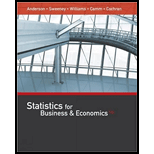
Concept explainers
Rating Wines from the Piedmont Region of Italy
Wine Spectator magazine contains articles and reviews on every aspect of the wine industry, including ratings of wine from around the world. In a recent issue they reviewed and scored 475 wines from the Piedmont region of Italy using a 100-point scale (Wine Spectator, April 30, 2011). The following table shows how the Wine Spectator score each wine received is used to rate each wine as being classic, outstanding, very good, good, mediocre, or not recommended.
| Score | Rating |
| 95–100 | Classic: a great wine |
| 90–94 | Outstanding: a wine of superior character and style |
| 85–89 | Very good: a wine with special qualities |
| 80–84 | Good: a solid, well-made wine |
| 75–79 | Mediocre: a drinkable wine that may have minor flaws |
| below 75 | Not Recommended |
A key question for most consumers is whether paying more for a bottle of wine will result in a better wine. To investigate this question for wines from the Piedmont region we selected a random sample of 100 of the 475 wines that Wine Spectator reviewed. The data, contained in the file named WineRatings, shows the price ($), the Wine Spectator score, and the rating for each wine.
Managerial Report
- 1. Develop a table that shows the number of wines that were classified as classic, outstanding, very good, good, mediocre, and not recommended and the average price. Does there appear to be any relationship between the price of the wine and the Wine Spectator rating? Are there any other aspects of your initial summary of the data that stand out?
- 2. Develop a
scatter diagram with price on the horizontal axis and the Wine Spectator score on the vertical axis. Does the relationship between price and score appear to be linear? - 3. Using linear regression, develop an estimated regression equation that can be used to predict the score given the price of the wine.
- 4. Using a second-order model, develop an estimated regression equation that can be used to predict the score given the price of the wine.
- 5. Compare the results from fitting a linear model and fitting a second-order model.
- 6. As an alternative to fitting a second-order model, fit a model using the natural logarithm of price as the independent variable. Compare the results with the second-order model.
- 7. Based upon your analysis, would you say that spending more for a bottle of wine will provide a better wine?
- 8. Suppose that you want to spend a maximum of $30 for a bottle of wine. In this case, will spending closer to your upper limit for price result in a better wine than a much lower price?
Trending nowThis is a popular solution!

Chapter 16 Solutions
Statistics for Business & Economics
 Glencoe Algebra 1, Student Edition, 9780079039897...AlgebraISBN:9780079039897Author:CarterPublisher:McGraw Hill
Glencoe Algebra 1, Student Edition, 9780079039897...AlgebraISBN:9780079039897Author:CarterPublisher:McGraw Hill Holt Mcdougal Larson Pre-algebra: Student Edition...AlgebraISBN:9780547587776Author:HOLT MCDOUGALPublisher:HOLT MCDOUGAL
Holt Mcdougal Larson Pre-algebra: Student Edition...AlgebraISBN:9780547587776Author:HOLT MCDOUGALPublisher:HOLT MCDOUGAL
 Big Ideas Math A Bridge To Success Algebra 1: Stu...AlgebraISBN:9781680331141Author:HOUGHTON MIFFLIN HARCOURTPublisher:Houghton Mifflin Harcourt
Big Ideas Math A Bridge To Success Algebra 1: Stu...AlgebraISBN:9781680331141Author:HOUGHTON MIFFLIN HARCOURTPublisher:Houghton Mifflin Harcourt



